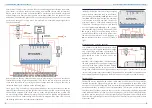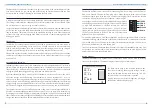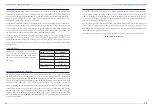
ZERO EMISSION VEHICLES AUSTRALIA
8-16 CELL LITHIUM BATTERY MANAGEMENT SYSTEM
Stationary Mode
The BMS16 has two main modes of operation, either normal (for mobile / EV applications)
or Stationary Mode (for off grid / backup battery type applications). In normal mode, if an
under- or over-voltage is detected, the LV or HV output relay will be disabled respectively,
and will remain off until the device is either power cycled or (more commonly) they are re-
enabled whenever the device wakes from sleep.
In Stationary mode, the outputs will automatically reset if the voltage recovers sufficiently.
The BMS Hysteresis setting is used to adjust the amount that the voltage needs to recover
before outputs are re-enabled. For example, if the HV output has been disabled due to an
over-voltage cell, a Hysteresis setting of 0.2V will prevent the output from re-enabling until
the high cell has fallen more than 0.2V below the Max Voltage setting.
Common settings for LiFePO4 cells are a
Min Voltage
setting of 2.50V,
Max Voltage
of 3.65V,
and
Hysteresis
of 0.20V, giving a 2.5V-2.7V band for the LV Relay output and 3.45V-3.65V
band for the HV Relay output. LiCo cells have a more linear charge curve so typically need a
smaller hysteresis band around 0.10V, with a
Min Voltage
setting of 3.00V and a
Max Voltage
setting of 4.2V.
LED Status Codes
The BMS has a bicolour (red/green) LED
which it uses to display its operating
status. The table to the right summarises
the colour codes for the possible statuses
indicated.
Status
Colour
Running (no errors)
Green
Sleeping
Blinking green
Under-voltage trip
Flashing red
Over-voltage trip
Steady red
Thermal trip
Flashing red/green
BMS Power Consumption Protection
An inherent problem with any BMS which powers itself from the cells it is monitoring is that
the BMS itself can slowly discharge the cells, which can eventually flatten cells – particularly
if powering contactors or monitors, and no charging source is present for an extended period.
To prevent possible damage, the BMS16 is able to switch of its own power supply if any cells
get critically low (under 2.0V). If your BMS has turned off due to a critically low cell, simply
attach a charging source to the batteries then press the power button to re-enable the BMS.
If the battery system is not in use for a while (days to weeks) it is recommended to put the
BMS to sleep by joining the Sleep terminal to Ground, to reduce power consumption. If the
system will not be used for a long time (weeks or longer) it is recommended to turn the BMS
off, by bringing up Options buttons then tapping Power Off (or unplug the cell connector, if
you have no Monitor).
Tech Support and Warranty Information
All ZEVA products are covered by a 12 month warranty against manufacturing faults or
failures under normal operating conditions. The warranty does not cover misuse of the
product, including but not limited to: excessive voltage or reversed polarity on terminals,
short circuits on outputs, opening of housings and/or modification of internal electronics,
severe impact damage, submersion in water.
We have taken great care to design a safe and reliable product, but faults can happen. If
you believe your product has a fault, please contact us via our website to discuss. If it is
determined that a hardware fault is the likely cause, we will provide an RMA number and
return address to proceed with repairs.
If you have any questions not covered by this manual, please contact us via our website:
http://www.zeva.com.au
11
12






